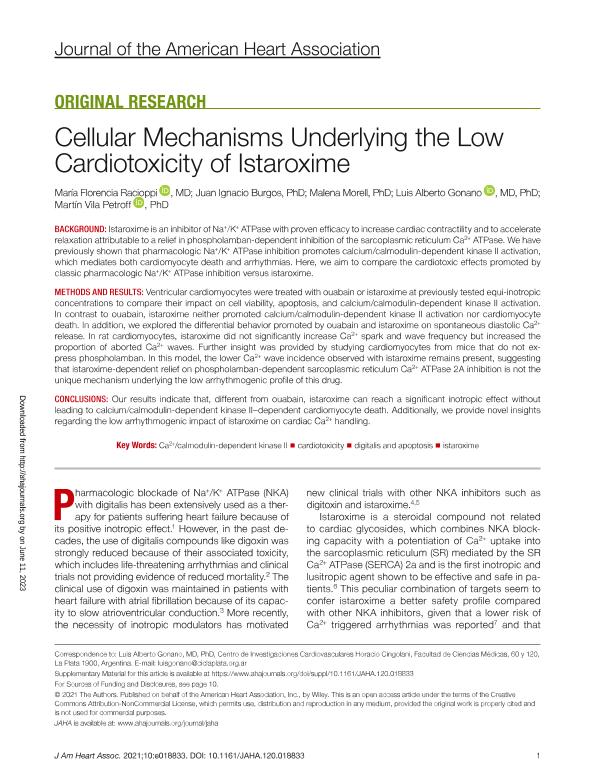Artículo
Cellular mechanisms underlying the low cardiotoxicity of istaroxime
Racioppi, María Florencia ; Burgos, Juan Ignacio
; Burgos, Juan Ignacio ; Morell, Malena
; Morell, Malena ; Gonano, Luis Alberto
; Gonano, Luis Alberto ; Vila Petroff, Martin Gerarde
; Vila Petroff, Martin Gerarde
 ; Burgos, Juan Ignacio
; Burgos, Juan Ignacio ; Morell, Malena
; Morell, Malena ; Gonano, Luis Alberto
; Gonano, Luis Alberto ; Vila Petroff, Martin Gerarde
; Vila Petroff, Martin Gerarde
Fecha de publicación:
07/2021
Editorial:
American Heart Association
Revista:
Journal of the American Heart Association
ISSN:
2047-9980
Idioma:
Inglés
Tipo de recurso:
Artículo publicado
Clasificación temática:
Resumen
BACKGROUND: Istaroxime is an inhibitor of Na+/K+ ATPase with proven efficacy to increase cardiac contractility and to accelerate relaxation attributable to a relief in phospholamban-dependent inhibition of the sarcoplasmic reticulum Ca2+ ATPase. We have previously shown that pharmacologic Na+/K+ ATPase inhibition promotes calcium/calmodulin-dependent kinase II activation, which mediates both cardiomyocyte death and arrhythmias. Here, we aim to compare the cardiotoxic effects promoted by classic pharmacologic Na+/K+ ATPase inhibition versus istaroxime. METHODS AND RESULTS: Ventricular cardiomyocytes were treated with ouabain or istaroxime at previously tested equi-inotropic concentrations to compare their impact on cell viability, apoptosis, and calcium/calmodulin-dependent kinase II activation. In contrast to ouabain, istaroxime neither promoted calcium/calmodulin-dependent kinase II activation nor cardiomyocyte death. In addition, we explored the differential behavior promoted by ouabain and istaroxime on spontaneous diastolic Ca2+ release. In rat cardiomyocytes, istaroxime did not significantly increase Ca2+ spark and wave frequency but increased the proportion of aborted Ca2+ waves. Further insight was provided by studying cardiomyocytes from mice that do not express phospholamban. In this model, the lower Ca2+ wave incidence observed with istaroxime remains present, suggesting that istaroxime-dependent relief on phospholamban-dependent sarcoplasmic reticulum Ca2+ ATPase 2A inhibition is not the unique mechanism underlying the low arrhythmogenic profile of this drug. CONCLUSIONS: Our results indicate that, different from ouabain, istaroxime can reach a significant inotropic effect without leading to calcium/calmodulin-dependent kinase II–dependent cardiomyocyte death. Additionally, we provide novel insights regarding the low arrhythmogenic impact of istaroxime on cardiac Ca2+ handling.
Archivos asociados
Licencia
Identificadores
Colecciones
Articulos(CCT - LA PLATA)
Articulos de CTRO.CIENTIFICO TECNOL.CONICET - LA PLATA
Articulos de CTRO.CIENTIFICO TECNOL.CONICET - LA PLATA
Articulos(CIC)
Articulos de CENTRO DE INVEST.CARDIOVASCULARES (I)
Articulos de CENTRO DE INVEST.CARDIOVASCULARES (I)
Articulos(CITAAC)
Articulos de CENTRO DE INVESTIGACIONES EN TOXICOLOGIA AMBIENTAL Y AGROBIOTECNOLOGIA DEL COMAHUE
Articulos de CENTRO DE INVESTIGACIONES EN TOXICOLOGIA AMBIENTAL Y AGROBIOTECNOLOGIA DEL COMAHUE
Citación
Racioppi, María Florencia; Burgos, Juan Ignacio; Morell, Malena; Gonano, Luis Alberto; Vila Petroff, Martin Gerarde; Cellular mechanisms underlying the low cardiotoxicity of istaroxime; American Heart Association; Journal of the American Heart Association; 10; 14; 7-2021; 1-14
Compartir
Altmétricas



